| Writer | Topic: Mission Henri Lhote facsimile fakes | alTakruri
Fellow member
Member # 10195 Rate Fellow member |  posted posted     
Can someone who tin copy consummate GOOGLE BOOKS pages delight post
pp.206-213 and pp.216-217 from Keenan'southward The lesser gods of the Sahara.Some frauds attested to at that place are reproduced in
Lhote's (1959) The Search for the Tassili Frescoes They are #26. Jabbaren: Scene of Offerings. Egyptian Influence #33. Jabbaren: 'Antinea': Post-Bovidian Period with Egyptian Influence I. Jabbaren. The Bird-HeadedGoddesses. Egyptian Influence. #48. Ti-n-Tazarift: The Dancers: Post-Bovidian Menstruation with Egyptian Influence In examining them one gets clues also 1's
common creative sense in discerning technique,
style, and subject matter of the fakers. Of class by studying the not-fraudulent pieces
one learns the techniques, styles, and subject field
matters of the authentic neolithic and aboriginal
Saharan artists. Lhote's commentary on the above admitted fakes
describing their characteristics and themes also
give pointers to other similar works that may too
be highly suspected of fraud. Tourists take snapped many Tassili rock art pieces.
When there are no in situ photos of a Mission Henri
Lhote facsimile reproduction what is one to conclude? Since certified frauds were confessed by guilty
members of Lhote's team I've get leary of
meticulously executed "Saharan rock art" that's
unverified past photo.
Posts: 8014 | From: the Tekrur in the Western Sahel | Registered: February 2006 | IP: Logged |  | | | | alTakruri
Member
Member # 10195 Charge per unit Member |  posted posted     
An example of how the fakes influenced historical anthropology. 
Jabbaren: 'Antinea': Post-Bovidian Period with Egyptian Influence Other than touch ups to the breast, thigh, and buttocks
the to a higher place reworking is the same as in Lhote's volume. Lhote's commentary:
This magnificent female figure was institute in the so-called
'Aard-Vark' shelter at Jabbaren where it is situated in the least
accessible function of the grotto and screened from outside by a
huge rock. The shelter had been occupied (previously to the
execution of the paintings) by Bovidians, who left here remains
of their repasts and a number of artifacts. The great picture
covers, to the extreme right, a footling round-headed effigy, while
a Bovidian personage in red ochre seems to take been em-
bodied in the head-dress of 'Antinea'. The profile is typically
'European' -- Greek 1 might almost say. It is in marked
contrast with the coarse faces of the 'magistrates' (No. xxx)
and of the women of the Upper Jabbaren (List of Styles No. ane)
which, still, belong to the same fine art-stage and are all
executed in similar colors. The head-dress seems to indicate
an important personage. Hither, once more, we see the head-
band or loftier cap which is characteristic of this school of
painting, but the upper role of the head-clothes is dissimilar and
appears to comprise an aspect whose form is not unlike that
of the Egyptian pshent. The manus seems to be covered past a frill
or finge.
Posts: 8014 | From: the Tekrur in the Western Sahel | Registered: Feb 2006 | IP: Logged |  | | Calabooz '
Member
Member # 18238 Rate Member |  posted posted     
Guess I'll repost this: quote:
The reason for this unfortunate country of affairs is that the Tassili-n-Ajjer, more than any other Saharan region, has been field of study to an appalling record of personal appetite, greed, looting, fraud, fakery and just almost everything else that can give archaeology, or whatsoever other discipline for that thing, a bad proper noun. All of this was documented in the original and subsequent versions of The Lesser Gods, which was a long-overdue intellectual and character assassination of Henri Lhote,half-dozen the self-proclaimed discoverer of the Tassili frescoes.seven I volition therefore non echo what I take already written, other than to summarise Lhote�s main contributions to this disgraceful record. Lhote did not observe the Tassili frescoes as most of his writing and self-publicity
would accept us believe. Almost of the sites recorded by Lhote had already been seen by an extraordinary Frenchman, Lieutenant Brenans, much of whose work was plagiarised by Lhote and many of whose original notebooks and sketches were deliberately destroyed by Lhote. Earlier exploratory work had also been undertaken past Leo Frobenius (1937) and Yolande Tschudi (1955a, 1955b). Both Brenans and Lhote were indebted to the famous Tuareg guide Jebrine ag Mohammed, to whom the Tassili park is now commemorated and who would no doubt have brought the paintings to the earth�s attention through his own writing
if he had been able to write. Lhote also set out to destroy the record (and life-piece of work) of Yolande Tschudi (1955a, 19955b), the first person actually to record the Tassili paintings in colour and to try dating them. He largely succeeded. Tschudi is yet alive and living near Zurich. Particularly serious from the archaeological perspective is that many of the paintings
that Lhote recorded are ones that he faked. At least eight of them, (and possibly as many equally 12), have been identified and recorded. However, long discussions with Lhote�southward copying team during the class of making the film The Lesser Gods revealed that in that location are �dozens of fakes�. The word dozens should be treated with caution. From carefully interviewing surviving members of Lhote�s squad, my own team of researchers were led to believe that at least a dozen well-known recorded paintings are fakes. To the dozen that nosotros have confirmed, it appears that the reference to dozens (plural) refers to the copiers� practice of making many paintings, often merely to amuse themselves and pass the time of day, which were rapidly destroyed or removed. However, even though
these �fakes� may no longer exist on the rock faces, we do not know if they accept 120 Journal of Gimmicky African Studies been perpetuated in Lhote�s notes and other records. The key point nearly this new data is not that the number of fakes is greater than hitherto supposed, only that Lhote actually knew that they were fakes. The copiers stated that many of the �more important� fakes (that is, those published by Lhote) were done, in the words of one of the copyists, �to have the mickey� out of Lhote as he was then unpopular with his team. Some even described their feelings equally �hatred�. The copiers merits that in all cases they told Lhote that they had painted the fakes.8 Indeed, in near cases information technology was self-axiomatic, withal Lhote insisted on publishing them as real. Well-nigh of the copiers to whom my inquiry team spoke could non sympathize his motivation. I believe that in part it was to prove his �Egyptian thesis� (that the origin of Tassilian art was the Nile).9 Beyond that, the reason seems to lie in his boggling airs and psychological make-up. As shown in the picture, even when challenged, by Malika Hachid, the former director of the Tassili National
Park, to remove the �Egyptian Goddesses�, which had already been proven to be a fake, from later editions of his book, Lhote refused to do so. For the last 30 years or and so of his life he refused to admit that his team had painted fakes. Moreover, Lhote non just washed and publicly encouraged the washing of the paintings, thus accelerating their devastation, but besides reportedly looted surface and other artefacts in huge quantities from an unknown number of sites. It has been said by people who worked with him that what he did not have for the Mus�due east de l�Homme in Paris and the Bardo Museum in Algiers went into his individual drove, and that his private drove surpassed those of both museums.11 Indeed, Lhote undertook perhaps every bit many as a hundred excavations from which he is said to have removed (looted) artefacts without making any public record of them. Lhote also used his influence to terminate other academics and scientists visiting the region, thus preventing further research (and, of course, the discovery of his misdeeds). In brusk, Lhote was the major correspondent to the about sterilisation of the archaeological record of one of the world�south most important archaeological sites and the main crusade of much of the subsequent damage to the remaining art through deportment such as washing.
Source: Who Thought Rock Art Was About
Archæology? The Role of Prehistory in Algeria�s Terror: By Jeremy Keenan Journal of Gimmicky African Studies, 25,1, January. 2007 Much ameliorate in this thread --------------------
Fifty Writes:
Posts: 1502 | From: Dies Irae | Registered: October 2010 | IP: Logged |  | | alTakruri
Member
Fellow member # 10195 Rate Fellow member |  posted posted     
Thanks. When I used GOOGLE CHROME browser on my old
Windows XP running PC I could go to my PC's temp folder
and an image in entirety of each GOOGLE BOOKS page
would be there. Uploading 1 of them was a lot easier
than manually taking screen shots. But in that location's something easier still. MoM718 used to post the actual GOOGLE url prototype pages
themselves but I only get the id valeu for the first page
linked not any other pages in the volume that I coil to
subsequently that, and yous demand the sig and w values to link
directly to the page images themselves similar he did. quote:
Originally posted past L':
Similar so?. . . . Is the above what you wanted? Not certain if you can post Google Volume pages in HTML... Unless you want to type them yourself lol
Posts: 8014 | From: the Tekrur in the Western Sahel | Registered: February 2006 | IP: Logged |  | | | | Calabooz '
Member
Fellow member # 18238 Rate Fellow member |  posted posted     
Here is a quick quote I volition post:What Happened to the Ancient Libyans? Chasing Sources across the Sahara from Herodotus to Ibn Khaldun By Richard L. Smith quote:
In classifying the peoples of North Africa, Procopius offered the fewest categories, Libyans and Maures, friend and foe. He served every bit court historian for Emperor Justinian in the 6th century and wrote political and military history, not ethnography. While his division has some basis in location, it is substantially a political one.( n33) On the other extreme are Ptolemy and Ibn Khaldun, both of whom refer to scores of people. I of the virtually curious systems of categorization comes from Ibn Hawqal, who wrote in the late tenth century. A native of Baghdad, he traveled extensively in the western regions of Islam, where his curiosity led him to gather much information about the Sahara. At 1 bespeak in his work, he suddenly announces that his readers may become confused by the many Berber clans and tribes he mentions, so to assistance matters he divides them into the "pure Sanhaja" and the "Banu Tanamak," the difference beingness that the latter "were originally Sudan [blackness] whose pare and complexion became white because they alive close to the North."( n34) He lists nineteen names under the pure Sanhaja and twenty-two under the Banu Tanamak without indicating whether these are political, cultural, geographic, social, or linguistic in nature. Nor does he specify the difference between the Sanhaja and other Berbers.
It's well-nigh 43 pages long, but I retrieve it's pretty skillful.Edit: Guess at that place is no need for a download:
Read Here
Posts: 1502 | From: Dies Irae | Registered: October 2010 | IP: Logged |  | | | | | | | | | | | | | | Djehuti
Fellow member
Member # 6698 Rate Fellow member |  posted posted    
Bluntly I don't run across how Lohte could take been fooled by the "bird goddesses".  ^ The overall style and shapes are clearly unlike whatsoever of the other paintings. The three mounted ladies look more realistic.  But still the unpainted bodies and them being mounted on cattle forth with their hairdos that are contemporary with modern Fulani should enhance eyebrows.
Posts: 24560 | From: Atlanta, Georgia, Usa | Registered: Feb 2005 | IP: Logged |  | | | | alTakruri
Member
Member # 10195 Rate Member |  posted posted     
In 1966 Basil Davidson wrote the following caption
for the quartet of figures posted on ES AE&E as "The
Tassili Ladies, 3000 BC Algeria." WOMEN RIDERS mounted on horned oxen vesture
capes and hairdos astonishingly modern in
style. They are part of a scene which shows
a whole community moving to another camp. Underscoring and bolding by me. We now know why the clothes and 'dos evoke anachronism.  Women mounted on horned oxen. An entire community moves to a new region.
Frescoes of Tassili N'Ajjer, Algeria. 2nd manufactory. BCE.
Location :Musee de l'Homme, Paris, France
Photo Credit : Erich Lessing / Art Resource, NY
Prototype Reference : ART112955
Posts: 8014 | From: the Tekrur in the Western Sahel | Registered: Feb 2006 | IP: Logged |  | | | | | | Sundjata
Member
Member # 13096 |  posted posted    
^I didn't know about the male warriors from Jabbaren, thanks. Has it indeed been argued that the figures to a higher place are depicted accurately in their hue? I just run into transparent chalk, but maybe these scholars accept more going for them in discerning non-African cultural leanings. When are those pieces dated? The Tassili ladies over again, are said to date around 1,000 BC, which may still evoke feelings of anachronism but there were other paintings that were pretty much the same as far as the level of detail, depicting people with pretty much the same standards of attire. Such is included within the overall "Bovidian way", which Roset (2004) really attributes to the proto-Fulani. Indeed, paintings similar to the "Tassili ladies" show elaborately dressed brown-skinned men, one who is also riding oxen. This ane came to listen when I made the higher up statement (listen you, this is from the same menses every bit the Tassili ladies [2nd-1rst millenium BC]):   "Possibly a scene of jurisdiction. A man in the heart, possibly defendant of some crime, is led off by an official in striped glaze. Grouping of robed justices (?) on lower left. Fresco of Tassili North'Ajjer, Henri Lhote Drove" "Possibly a scene of jurisdiction. A man in the heart, possibly defendant of some crime, is led off by an official in striped glaze. Grouping of robed justices (?) on lower left. Fresco of Tassili North'Ajjer, Henri Lhote Drove" quote:
BTW Malika Hachid is a she.
Oops. Please disregard the sexist assumption.
Posts: 4021 | From: Bay Surface area, CA | Registered: Mar 2007 | IP: Logged |  | | | | | | the lioness,
Moderator
Member # 17353 Rate Member |  posted posted    
. Tassili paintings and engravings, like those of other rock art areas in the Sahara, are commonly divided into at least four chronological periods based on style and content. These are: i)an archaic tradition depicting wild animals whose antiquity is unknown only certainly goes back well earlier 4500 B.C. 2) a so-called bovidian tradition, which corresponds to the inflow of cattle in Northward Africa between 4500 and 4000 B.C. 3) a "equus caballus" tradition, which corresponds to the appearance of horses in the Northward African archaeological record from about 2000 B.C. onward 4) a "camel" tradition, which emerges around the time of Christ when these animals beginning appear in Northward Africa. Engravings of animals such as the extinct giant buffalo are among the earliest works, followed later by paintings in which color is used to depict humans and animals with striking naturalism. In the terminal period, chariots, shields, and camels announced in the stone paintings. While these traditions are successive, it does appear that earlier ones connected on for varying lengths of time after the advent of later ones. Ii important qualifiers need to be made. First, many scholars have recently questioned a pan-Saharan chronology and there is a move away from grandiose chronological schemes to concentrating more than on understanding regional chronological variability. 2d, the Sahara, given its vast size and various political complications, is still an inadequately researched surface area in terms of stone art and very few dates be. Equally more than work is done and techniques for dating advance, information technology is probable that this 4-period dating scheme will be modified in detail regions and that more will exist learned about the origins and demise of Saharan stone art. Department of Arts of Africa, Oceania, and the Americas, The Metropolitan Museum of Fine art Department of Arts of Africa, Oceania, and the Americas. "African Stone Art: Tassili-northward-Ajjer (?8000 B.C.�?) ". In Heilbrunn Timeline of Art History. New York: The Metropolitan Museum of Art, 2000�. http://www.metmuseum.org/toah/hd/tass/hd_tass.htm (October 2000)
Posts: 39760 | From: , | Registered: Jan 2010 | IP: Logged |  | | | | dana marniche
Member
Member # 13149 Rate Member |  posted posted     
quote:
Originally posted past alTakruri:
An example of how the fakes influenced historical anthropology. 
Jabbaren: 'Antinea': Postal service-Bovidian Menstruum with Egyptian Influence Other than touch on ups to the breast, thigh, and buttocks
the to a higher place reworking is the same every bit in Lhote's book. Lhote's commentary:
This magnificent female figure was found in the and so-called
'Aard-Vark' shelter at Jabbaren where it is situated in the least
accessible part of the grotto and screened from outside by a
huge rock. The shelter had been occupied (previously to the
execution of the paintings) by Bovidians, who left here remains
of their repasts and a number of artifacts. The not bad picture
covers, to the extreme right, a little round-headed effigy, while
a Bovidian personage in cherry ochre seems to take been em-
bodied in the caput-dress of 'Antinea'. The contour is typically
'European' -- Greek one might near say. It is in marked
dissimilarity with the coarse faces of the 'magistrates' (No. 30)
and of the women of the Upper Jabbaren (Listing of Styles No. i)
which, nevertheless, belong to the same art-phase and are all
executed in like colors. The head-dress seems to indicate
an of import personage. Here, once more, we run into the caput-
band or high cap which is feature of this school of
painting, just the upper part of the head-dress is different and
appears to comprise an attribute whose form is not different that
of the Egyptian pshent. The hand seems to be covered by a frill
or finge.
I hate to keep playing conspiracy theorist just...
anachronistic is understating things. 
I hope this is supposed to exist a rendition of the original painting.  From 1880 From 1880 
Karl Lagereld in the business firm... of Chanel that is. Some thing's never modify I guess - including European depictions of themselves. BTW - the poncho is ancient South American manner statement non an Iberian ane. They started wearing them in Europe during World War I about the fourth dimension colonialists were venturing into the Sahara engaging in their stone artistry then to speak. Not to nitpick but, for this reason I thus however have questions and reservations nearly the antiquity and age of this specific artwork where females appear to be wearing poncho-like articles of article of clothing.
Posts: 4226 | From: New Jersey, USA | Registered: Mar 2007 | IP: Logged |  | | | | | | | | Tukuler
Member
Member # 19944 |  posted posted     
Don't know why I'm bothering replying since you
always seek refuge in irrationality after being
refuted.Quite the contrary, I have never assessed skin
color in adjudging the Oxen Riders as fakes.
You are the i using skin colour as a crutch. In fact I've questioned the authenticity of the
so-chosen Filles Peuhl and they are quite dark.   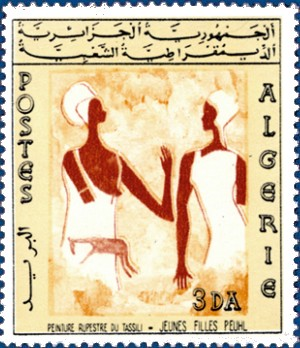  My stance on pale isle and north Mediterranean
females in N Africa in prehistory is well known
as in my view they partially business relationship for the lighter
skin tone of some North Africans. You are the 1
using light peel colour as a crutch not me. The Saharan woman you posted her headwrap looks
absolutely nothing like any of the hairstyles in the
art. It could never be mistaken for styled hair
whether bushy, brushed, or exquisitely coiffured. If you really knew anything about the region, the
time menses, and the people yous would know that
object atop the central figure'south caput yous cannot
place is an ostrich egg. Please post examples of female person turban habiliment dating
to ~1500 BCE in the Sahara. Every bit you know from earlier
posts on this topic the blonde sports a well known
hairstyle of last century sahel/savannah women and
is especially a Fulani adornment. Where in the fine art
or literature of the aboriginal Egyptians or Graeco-Latins
is in that location any indication of North African female turban wear?   Another point of fakery regarding the ravenette. You can see the facsimile
artist's endeavour at mascara or eyelash makeup in the line jutting the forehead. 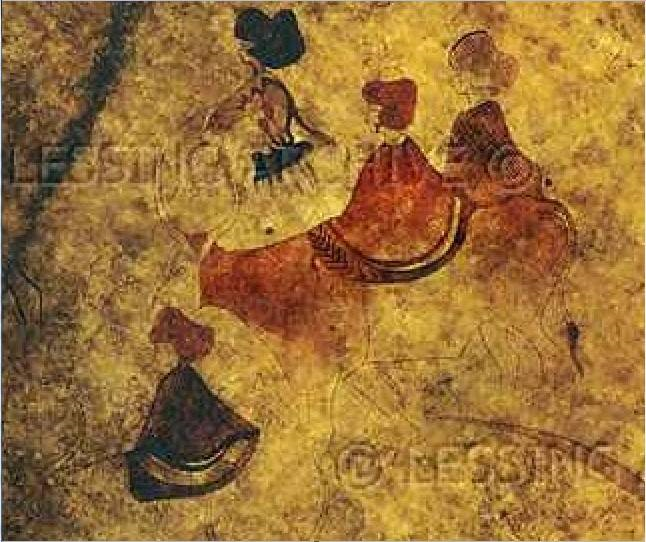 The intent of the artists making fakes, and they did
make fakes equally some confessed their misdeeds, was
chalked upward to boredom and pulling one over on the
boss. It is the boss, Henri Lhote, who'south to blame for any
falsifying of anthropology and history every bit he'southward the
one who fabricated such glowing disinforming writeups
similar the ane on Antinea fully quoted in an in a higher place
postal service. Hachid, who published some of the fakes in her work,
implies Lhote was aware of fraud merely lent the fakes
authenticity in back up of his own personal theories
on which, of course, his art coiffure heard him speak. 
Posts: 7598 | From: the Tekrur straddling Senegal & Mauritania | Registered: Dec 2011 | IP: Logged |  | | the lioness,
Moderator
Member # 17353 Charge per unit Fellow member |  posted posted    
quote:
Originally posted by Tukuler:
Don't know why I'chiliad bothering replying since you lot
e'er seek refuge in irrationality after existence
refuted.Quite the contrary, I accept never assessed pare
colour in adjudging the Oxen Riders as fakes.
You are the one using pare colour as a crutch. In fact I've questioned the actuality of the
then-called Filles Peuhl and they are quite dark. My stance on pale island and north Mediterranean
females in North Africa in prehistory is well known
as in my view they partially account for the lighter
pare tone of some North Africans. You are the one
using light pare colour as a crutch non me.
It is hard to determine, then, the reason yous made this thread, what you retrieve is relevant about them. quote:
Originally posted past Tukuler:The Saharan woman y'all posted her headwrap looks
absolutely nix like any of the hairstyles in the
fine art. Information technology could never be mistaken for styled hair
whether bushy, brushed, or exquisitely coiffured.
That is your opinon I disagree and dana had implied before that the intent was not hair. quote:
Originally posted by Tukuler:If yous really knew anything about the region, the
fourth dimension period, and the people yous would know that
object atop the central figure's head you cannot
identify is an ostrich egg.
Why would I identify the object on top of her head equally an ostrich egg? I never said anything about an ostrich egg. Please don't put words in my mouth. quote:
Originally posted by Tukuler:Delight mail service examples of female turban wear dating
to ~1500 BCE in the Sahara.
Why try to exercise this? The Tassili n'Ajjerrock fine art images cover a period of almost 10,000 years up to the 1st cnetury AD. Obviously the "Tassili Ladies" is most likely from a later period than 1500 BCE and the rock art in general has proven very difficult to appointment accurately. quote:
Originally posted by Tukuler:As yous know from earlier
posts on this topic the blonde sports a well known
hairstyle of concluding century sahel/savannah women and
is peculiarly a Fulani beautification. Where in the art
or literature of the aboriginal Egyptians or Graeco-Latins
is there any indication of North African female person turban wearable?  
what you conjecture does non brand sense. All the women take a similar situation on top of their heads. If their hair was in this particular style Fulani manner you show, you could not behave an object, what ever information technology is, in it as the person in the stone art is able to do:
 quote:
Originally posted by Tukuler:Another point of fakery regarding the ravenette. You tin run into the facsimile
artist's endeavor at mascara or eyelash makeup in the line bulging the brow.
that interpretation is a real stretch, the paradigm is poor quality and enlarged/pixilated and it doesn't evidence on the other version this picayune line which yous think represents imitation eyelashes only even so an authentic Fulani hair way   quote:
Originally posted by Tukuler:The intent of the artists making fakes, and they did
make fakes as some confessed their misdeeds, was
chalked upwardly to boredom and pulling one over on the
boss. It is the boss, Henri Lhote, who'southward to arraign for any
falsifying of anthropology and history as he'south the
one who made such glowing disinforming writeups
like the one on Antinea fully quoted in an above
post. Hachid, who published some of the fakes in her work,
implies Lhote was enlightened of fraud but lent the fakes
authenticity in support of his own personal theories
on which, of course, his art crew heard him speak.
Posts: 39760 | From: , | Registered: Jan 2010 | IP: Logged |  | | dana marniche
Member
Member # 13149 Rate Fellow member |  posted posted     
quote:
Originally posted by the lioness:
to a higher place dana besides seems to see these equally hats or some kind of headgear. The woman in the eye is too carrying an object on superlative of her caput. If the painting was an attept to look like European hair this is the closest hairstyle, notwithstanding different in the painting the hair is non covering the ear. It doesn't expect the same to me, the painting looks similar some sort of turban blazon thing   but plainly if you were trying to pull a scam you lot wouldn't attempt to imply a hairstyle from the 1900s unless joking.
To me the women are only wearing headgear and garments typical of NA.
The main issue people are having is the lack of skin darkness.If they were dark no one would be talking about what's on summit of their heads.
Al Takruri said "Another fraud tipoff, one woman is blonde, one redhead, one brunette, and one ravenette.' This is a peachy point and something I had not known or noticed earlier because of the apparently not very like rendition. A good mode to say "Wait we Europeans were all represented as the hamites."lol! The African woman you've shown here is a Tuareg as I call back, and they don't typically vesture turbans on their heads. To me neither the Fulani women with turned upward noses shown in Takruri's posting, nor the painted women riding oxen on this stone art look very authentic.
I don't know what the people who depicted this art was trying to depict on these women's heads or if they are just hairstyles all that I know is when I offset saw them they struck me as looking like something from an early Parisien French manner studio, and that is fifty-fifty earlier I knew Lhote had taken part in supposedly redoing them. And, what kind of traditional Berber garments wait cape0like ponchos lyin_ss. The Berber form of poncho is called the Djelaba and looks nothing similar the Euro-fad Mexican ones depicted hither. There are still women that ride oxen in the Sahel area, but they are chosen the Kanuri. The Garamantes traditionally rode oxen, only the Garamantes were considered Ethiopians. Isidore 6th c. said �at that place are three tribes of Ethiopians: Hesperians, Garamantes and Indians� (See Ix ii 128.in The Etymologies of Isidore of Seville, Stephen A. Barney, 2006, p. 199).
Posts: 4226 | From: New Jersey, Us | Registered: Mar 2007 | IP: Logged |  | | dana marniche
Member
Fellow member # 13149 Rate Member |  posted posted     
BTW - a Charles Finch contacted me on the Africa resource forum and said he went to come across the authentic portrayal of Libyan depicted in Lepsius catechism. He said it was cipher like the original. So what you have been trying to spread around the web is lies Lyin_ss. ![[Big Grin]](https://lh3.googleusercontent.com/blogger_img_proxy/AEn0k_tELWnXq_319toAnlDYtfjt0qkce0xAMK-8abwtQ3QuI55VUNBGXN_kT31iwApjlnK8DQ4zooixGe_ZJyPuWc7Ig-91VEY-zTSlTMR0GiZ_5Q=s0-d) Dr. Finch wrote -
"Lepsius falsified the colour of the Tamehou effigy. I only know this because I actually went into the tomb of Rames III in 1995 � one of the few times it was open to the public � specifically to wait at that Panel of Races. Equally is known, there are 4 racial types as depicted by Lepsius, but what is non known is that the Panel is reproduced 4 times with the aforementioned figures. I don�t know why. Merely that is not the issue; what is the outcome is that the figure of the Tamehou in the tomb of Rameses III is NOT white, only a deep blood-red brown, looking FOR ALL THE Earth Similar MASAI IN COLORING. One would But know this by looking at the Console �contiguous� inside the tomb. Again, Lepsius (c. 1844) � it must have been deliberate � depicted the Tamehou in the wrong color! To my disappointment, it was impossible to have a picture show of this remarkable Panel. Cheikh Anta Diop obviously had never actually been inside the tomb of Rameses Three, as then many have not, then took Lepsius�south depiction as authentic. I might add the Aamu, representing the Asiatics were As well depicted every bit a deep, reddish dark-brown rather than the biscuit colour represented by Lepsius. Lepsius�due south version of the Console is printed in color as a frontispiece to Van Sertima�s EGYPT REVISTED (1989/1991)." UNQUOTE! Why am I astonished only not surprised?! Because I go on trying to give early European intelligensia the benefit of the uncertainty. BUT ITS NOT WORKING! And I've been as brainwashed as everyone else because I tin can still inappreciably believe it!
Posts: 4226 | From: New Jersey, The states | Registered: Mar 2007 | IP: Logged |  | | KING
Fellow member
Fellow member # 9422 Rate Member |  posted posted    
dana marniche Dandy Observe Dana. So until they allow public access to this tomb, people will however brand mistakes about merely what color the Tamehou and the Aamu were. I volition always believe in Blacks, Euros etc, but this prevarication could hands be debunked if the public was allowed to take pics of the original. Sadly though, people similar Hawass are pushing the not black Arab republic of egypt so thats reason to hide the TRUTH from the People. Only As we encounter with the links to Africa in the DNA TRIBE study, you tin can only agree down truth for an short fourth dimension, in the end Truth volition trump lies. We merely gotta be patient. Peace
Posts: 9193 | From: Peace and Love Metropolis. | Registered: Oct 2005 | IP: Logged |  | | the lioness,
Moderator
Member # 17353 Rate Fellow member |  posted posted    
quote:
Originally posted by dana marniche:
BTW - a Charles Finch contacted me on the Africa resource forum and said he went to see the authentic portrayal of Libyan depicted in Lepsius catechism. He said it was nothing similar the original. So what you accept been trying to spread effectually the web is lies Lyin_ss. ![[Big Grin]](https://lh3.googleusercontent.com/blogger_img_proxy/AEn0k_tELWnXq_319toAnlDYtfjt0qkce0xAMK-8abwtQ3QuI55VUNBGXN_kT31iwApjlnK8DQ4zooixGe_ZJyPuWc7Ig-91VEY-zTSlTMR0GiZ_5Q=s0-d) Dr. Finch wrote -
"Lepsius falsified the colour of the Tamehou effigy. I but know this because I actually went into the tomb of Rames 3 in 1995 � 1 of the few times it was open to the public � specifically to look at that Panel of Races. As is known, there are iv racial types as depicted past Lepsius, but what is not known is that the Panel is reproduced 4 times with the aforementioned figures. I don�t know why. But that is not the outcome; what is the event is that the figure of the Tamehou in the tomb of Rameses 3 is Non white, just a deep ruby-red brown, looking FOR ALL THE WORLD Similar MASAI IN COLORING. I would ONLY know this by looking at the Panel �contiguous� inside the tomb. Over again, Lepsius (c. 1844) � it must have been deliberate � depicted the Tamehou in the wrong color! To my thwarting, it was impossible to accept a picture of this remarkable Panel. Cheikh Anta Diop obviously had never actually been inside the tomb of Rameses III, equally so many have not, so took Lepsius�south depiction as authentic. I might add together the Aamu, representing the Asiatics were ALSO depicted as a deep, reddish brown rather than the beige colour represented past Lepsius. Lepsius�south version of the Panel is printed in color as a frontispiece to Van Sertima�due south EGYPT REVISTED (1989/1991)." UNQUOTE! Why am I astonished but not surprised?! Because I keep trying to give early European intelligensia the benefit of the doubt. But ITS Not WORKING! And I've been as brainwashed as everyone else because I can still inappreciably believe it!
dana jackass, alTakruri has mentioned the KV11 - Lepsius 1859 numerous times before me without raising this result y'all are talking aboutexample: Nile valley Forum 2008: http://thenile.phpbb-host.com/sutra7028.php quote:
Originally posted by alTakruri:The Tjemehhu were Africans, some of whom were very
heavily intermixed with north Mediterraneans ranging
from the Tyrrhenian to the Ionian to the Aegean. _______________________________________ Lepsius' condensation (Denkmaeler Supplement plate 48 is indeed
accurate and accurate. In it you can see another condensation of
the same scene just from a different tomb in the upper right. That
condensation is from KV8 (Merenptah's tomb). Paintings from the Book of Gates the Gate of Teka Hra vignette xxx
from tombs of the 19th and 20th dynasties: 1) KV8 Merenptah (i the many ignored ones
two) KV11 Rameses Iii (the controversial one
3) KV17f Seti I (the most commonly shown i BG 4:5 scene 30 as in KV8 tomb of Merneptah  BG 4:five s30 as in KV11 tomb of Rameses III
Denkmaeler supplement plate 48 condensations  
________________________________________________________________________^^^^Libyan Temehu (Tjemehhu)
____________Photo of Tomb Wall Ramesses III, Eric Hornung 1982
Posts: 39760 | From: , | Registered: January 2010 | IP: Logged |  | | | | dana marniche
Member
Member # 13149 Rate Fellow member |  posted posted     
quote:
Originally posted by Tukuler:
DanaI wouldn't be concerned with the Lying Ass every bit their
Phuckuptions are well known and readily apparent as
in their 2 Feb tenth posts. I leave the acute reader to
run into through their non-sequitors in reply to my last post. Some confusion over Book of Gates scene 30 in Ramesses Iii
tomb may exist due to defoliation between its representation in
ii separate chambers, i in chamber F and one in chamber
J if I'grand not mistaken. It may be true that in some cases Lepsius' artists
veered from the exact colors on the wall though off
hand I tin't recall an instance now. In Plate 48 the
2nd and fourth groups are low-cal, the 2d slightly lighter
than the 4th. Photos seem to vouch for Lepsius' accuracy,
but then again on close inspection in that location does appear to exist
some touchup in the photo or wash washed on the tomb wall.  But this affair really belongs in one of the Ampim vs
Yurco or KV11 BG s.thirty threads so as not to detract from
this thread'due south theme of uncovering Mission Lhote fakes
other than those already attested in the literature. Thanks in accelerate to all for staying on topic and
discussing Ramesses III's KV11 BG southward.30 elsewhere.
 OK it will exist ended here then equally long equally people realize that this moving picture beneath is the same equally the above man meridian on the left plain photoshopped by somebody into something 8xs lighter. 
Real Lepsius rendition? I will also be asking Dr. Finch if these are the Libyans he is talking about.
Posts: 4226 | From: New Jersey, Us | Registered: Mar 2007 | IP: Logged |  | | | | dana marniche
Member
Member # 13149 Rate Fellow member |  posted posted     
quote:
Originally posted by the lioness:
^^^^ dana you have a photo that says "real Lepsius rendition" That is a photo not a Lepsius rendition. Lepsius did the analogy version not the photograph.
Above are photos. Below the source, Hornung's photo
 ^^^ this photograph is a yellowed version with the wall background color appears a yellowish sand looking color not quite accurate to the wall color. The wall behind the figures is painted white as is shown more than accurately below, same figures:
This was sent to me this yr by Dr. Finch who visited the same tombs Lepsius saw."Sent: Saturday, March x, 2012 nine:07 PM
Subject: Re: Fw: Libyans of Lepsius depictions - photo attached '... in the tomb of Rameses III the generic Temehou branch of the Libyans is depicted as deep, nighttime reddish-brown in color, rather like the Masai. This is the Egyptians giving visual testimony of this branch of African neighbors. I would challenge the rebutters to go into the tomb of Rameses III and encounter for themselves. Just wish someone had taken a clear, brilliant picture once upon a time considering now, of grade, you tin't. We depend too much on the decolorized version presented to the globe by Lepsius.'" THUS until I come across some photos of Masaai colored Libyans from the tomb that Lepsius depicted your picture spam ARGUMENT IS NULL AND VOID! ![[Wink]](https://lh3.googleusercontent.com/blogger_img_proxy/AEn0k_sIQ8HR3xVnXqMs5xOjfmRHt3oboNERQBi8WAcC1yX_5BJNMgnK2ZsEtVMUveN_Uy8GkmU6pNmmnB60X3-D1jxNvotRdAK9f18-twOHJQ=s0-d)
Posts: 4226 | From: New Jersey, U.s.a. | Registered: Mar 2007 | IP: Logged |  | | | | Tukuler
Member
Member # 19944 |  posted posted     
^In response to the Henn thread on Egyptology
where suspected of fraud because white.  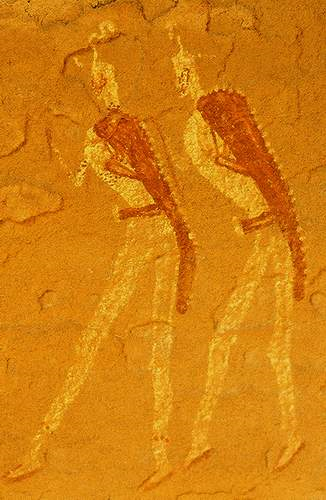  Pick upward Muzzolini's Sahariens and Hachid'south Berberes
before crying fake. Hachid let on "Antinea" was imitation. Again, until a quantatative review of Tin Anneuin
and Iheren-Tahilahi Last Bovidian to kickoff Horse
period fine art is undertaken, crying false is biased
chauvinism against white/near white admixed NAs. None of the above are Lhote facsimiles.
Two of them are obviously photographs. The Lhote fakes are limited. At the actual site
they are faded away barely traces left. Merely
because you don't similar what an accurate
painting (Kel guide can locate it; it
appears in tourist/non-professional
photo albums) is little reason to
declare a false. In that location were black fakes as well btw.
Posts: 7598 | From: the Tekrur straddling Senegal & Mauritania | Registered: Dec 2011 | IP: Logged |  | | | | Tukuler
Member
Member # 19944 |  posted posted     
'Prof' Marniche vindicated!! Gimme some hot sauce wimme society o crow wings, pls. quote:
Originally posted by dana marniche:
quote:
Originally posted by the lioness:
^^^^ dana you take a photograph that says "real Lepsius rendition" That is a photo non a Lepsius rendition. Lepsius did the illustration version not the photograph.
In a higher place are photos. Below the source, Hornung'due south photo
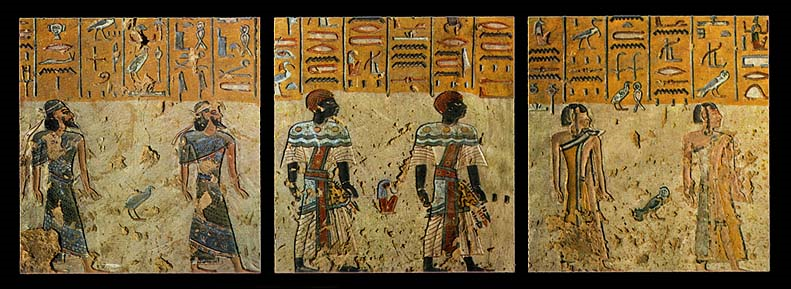 ^^^ this photo is a yellowed version with the wall groundwork color appears a yellowish sand looking color not quite authentic to the wall color. The wall behind the figures is painted white as is shown more accurately below, aforementioned figures:
This was sent to me this twelvemonth by Dr. Finch who visited the same tombs Lepsius saw."Sent: Sat, March x, 2012 nine:07 PM
Subject: Re: Fw: Libyans of Lepsius depictions - photo attached '... in the tomb of Rameses III the generic Temehou branch of the Libyans is depicted as deep, night reddish-dark-brown in colour, rather like the Masai. This is the Egyptians giving visual testimony of this branch of African neighbors. I would challenge the rebutters to get into the tomb of Rameses 3 and encounter for themselves. Simply wish someone had taken a articulate, brilliant picture once upon a time because now, of course, you tin can't. We depend too much on the decolorized version presented to the world by Lepsius.'" THUS until I meet some photos of Masaai colored Libyans from the tomb that Lepsius depicted your picture show spam Statement IS NULL AND VOID! ![[Wink]](https://lh3.googleusercontent.com/blogger_img_proxy/AEn0k_sIQ8HR3xVnXqMs5xOjfmRHt3oboNERQBi8WAcC1yX_5BJNMgnK2ZsEtVMUveN_Uy8GkmU6pNmmnB60X3-D1jxNvotRdAK9f18-twOHJQ=s0-d)
.After all these years har tis oh my tAmenukalt, w/apologies. 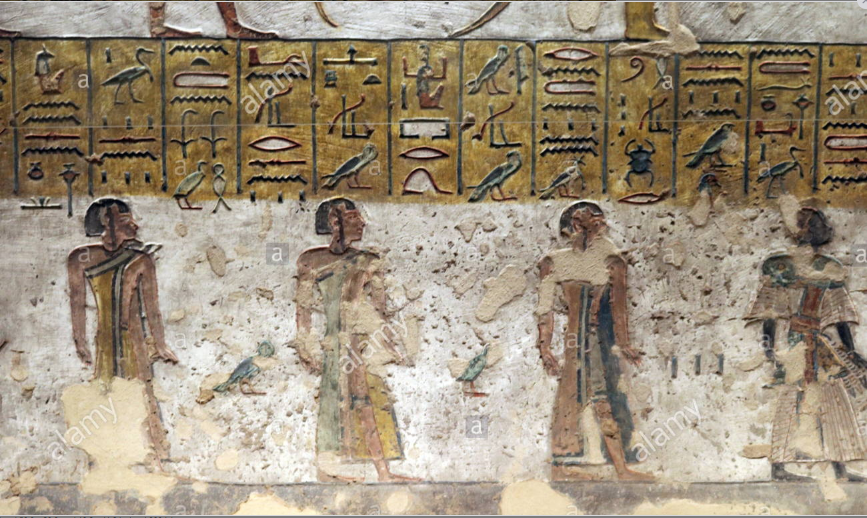 Hornung knew he was perpetrating fraud --------------------
I'grand just another point of view. What'south yours? � 2004 - 2022 YYT al~Takruri
Authentic Africana over race-serving ethnocentricisms, Afro, Euro, or whatever.
Posts: 7598 | From: the Tekrur straddling Senegal & Islamic republic of mauritania | Registered: Dec 2011 | IP: Logged |  | | | | Tukuler
Fellow member
Member # 19944 |  posted posted     
Non this mess again nothings wrong w/t glyphs.
Gone over that w/u 10 years at present and volition only become
over again for a Newbie as everyone else is tired
of it.1 may validly posit 'wrong image'.
Just seen ane instance of aberrant text
and that example has out of guild/
/pastiche epitome(s) besides. THE ORDER OF THE TEXT NEVER VARIES
Any MORE THAN THE ORDER OF SUNRISE
Noon AND SUNSET EVER VARY. Only expect at text gild in your own graphic.
The four major ethnies in top & bottom panels
line up perfectly given Lepsius' omission of
Tjemehu text in tiptop console. =-=-= In "Dana'southward pic" simply the flesh is brown.
Zippo next to its outlines display brown. Dana said there was a brown Tjemehu photo of
this scene and hither it is merely equally she said.
Unevenness of tint head to toe is evident. Tjemehu, equally a form including all to Egypt'south
west, vary in complexion since the chocolate-brown
Tjehenu of the OK to the beige 'Meshwesh'
of the NK who ruled several LP dynasties. In keeping with the Afterdeath theme of
this funerary volume, knowing AEs considered
the west as 'country of the dead', paler beige
rather than warmer dark-brown is the Libyan
complexion norm in all painted scenes I've
seen of this sacred to AEs chapter and poetry. --------------------
I'm just another point of view. What's yours? � 2004 - 2022 YYT al~Takruri
Authentic Africana over race-serving ethnocentricisms, Afro, Euro, or whatever.
Posts: 7598 | From: the Tekrur straddling Senegal & Islamic republic of mauritania | Registered: Dec 2011 | IP: Logged |  | | the lioness,
Moderator
Fellow member # 17353 Rate Member |  posted posted    
quote:
Originally posted by Tukuler:
[QB] Not this mess once again nothings wrong w/t glyphs.
Gone over that w/u ten years now and volition only go
once again for a Newbie as everyone else is tired
of it.One may validly posit 'wrong image'.
Merely seen i case of abnormal text
and that instance has out of order/
/pastiche image(south) too. THE Club OF THE TEXT NEVER VARIES
Any More than THAN THE Social club OF SUNRISE
Noon AND Dusk EVER VARY. Just look at text order in your own graphic.
The iv major ethnies in acme & lesser panels
line up perfectly given Lepsius' omission of
Tjemehu text in tiptop panel.
Yes, I have updated here: 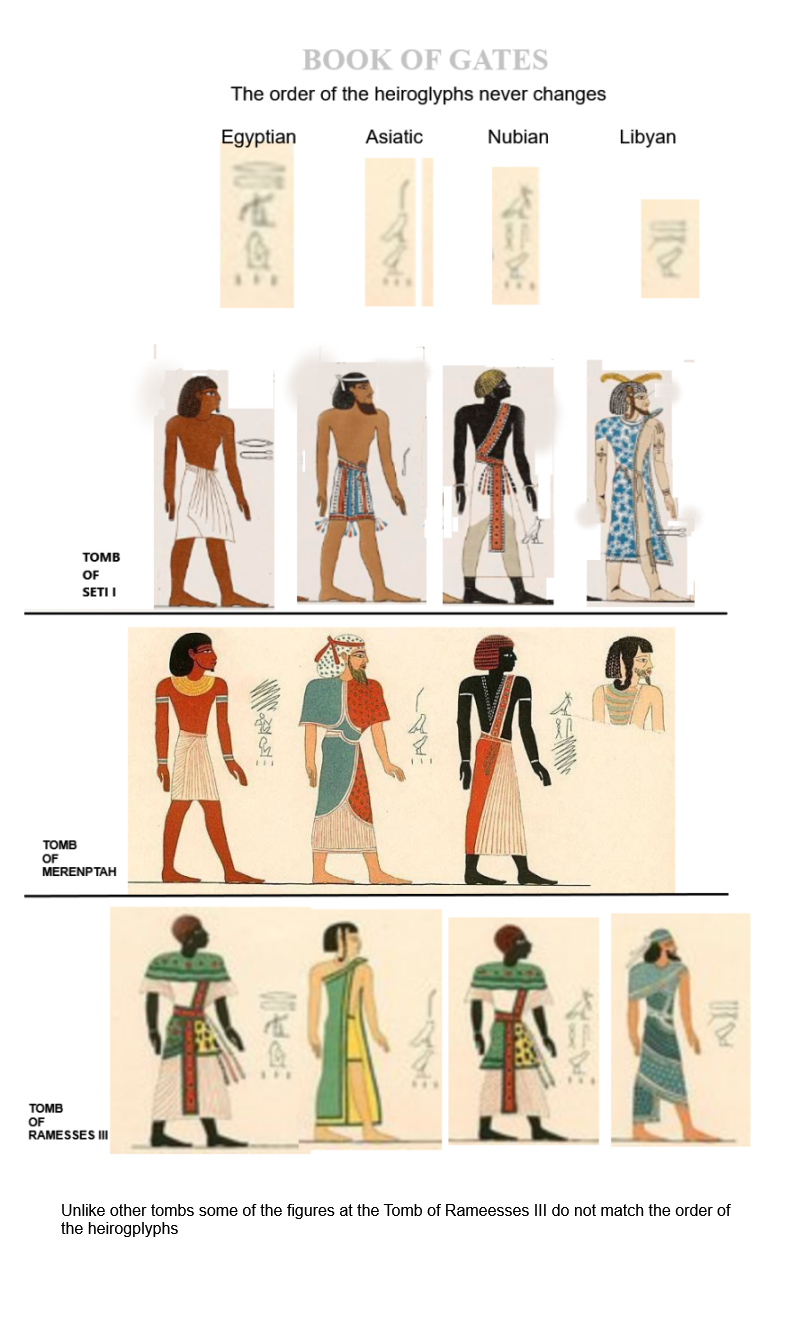
Book of Gates Seti I , Merenptah , Ramesses III
Fourth division , Fith Hour
Posts: 39760 | From: , | Registered: Jan 2010 | IP: Logged |  | | | | the lioness,
Moderator
Member # 17353 Rate Fellow member |  posted posted    
It took me a while to put that together but the resolution is not that great on some of it. I kept the typical names for laymen's sake.
Then to make everything consistent and lined upward in that location is the glyph to the correct of each effigy.
I noticed in Seti I that on the full version with iv figures each obviously G43, quail chick or one of the birds is in both Nehesy and Libyan figures sets
and so this runs through both sets of four figures.
(not sure if the bottom in Libyan is different or not)
Thus the key distinguishing glyph of the compound glyphs is the first glyph, the pinnacle glyph to the right of the first figure. Thus Asiatic = throw stick T14 is the central glyph
Libyan = chord V13
For example looking at the photo that has iii of the Libyans the first figure is not shown. That would have the chord V13the chord V13 is besides the second glyph for Egyptian, however the distinguishing commencement glyph is
Egyptian = mouth D21 (missing at Merenptah) and so the first glyph
Nehesy = Vulture G1 These single glyphs at the acme are incomplete only I choose to go out the glyph position at Seti I as it is on the original illustration, not condensed, every bit it is on the wall, broken upwardly > but the kickoff figure's glyph the key identifying one in these Book of Gates scenes, the reason not necessary that information technology is nearly important but that tiptop glyph is dissimilar for every nation in this situation while the other glyphs tin can be in more than than one nation It seems a good idea to commencement prove the total set of glyphs in social club by themselves, to let that prepare the tone of interpretation rather than the middle jumping to the figures first because these glyphs are maintaining consistency not the figures
and then at the various tombs and lined upward on a consistent manner, to make information technology easier to just look at compare visually
Posts: 39760 | From: , | Registered: Jan 2010 | IP: Logged |  | | | | | | | | | | |
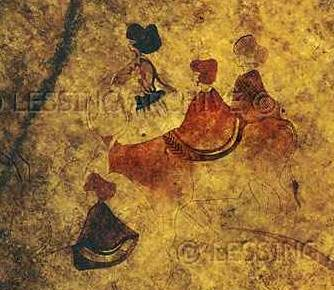
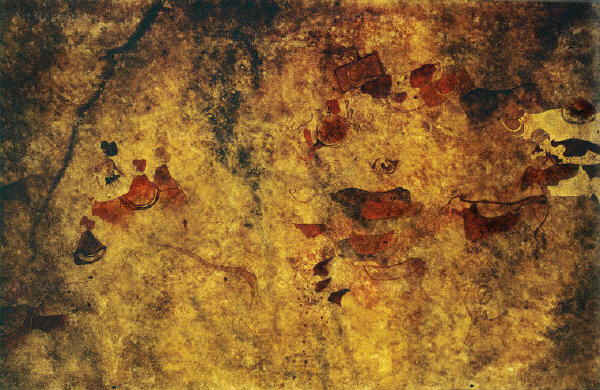
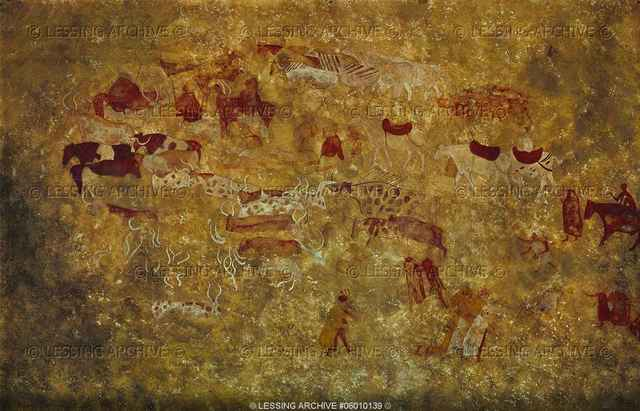



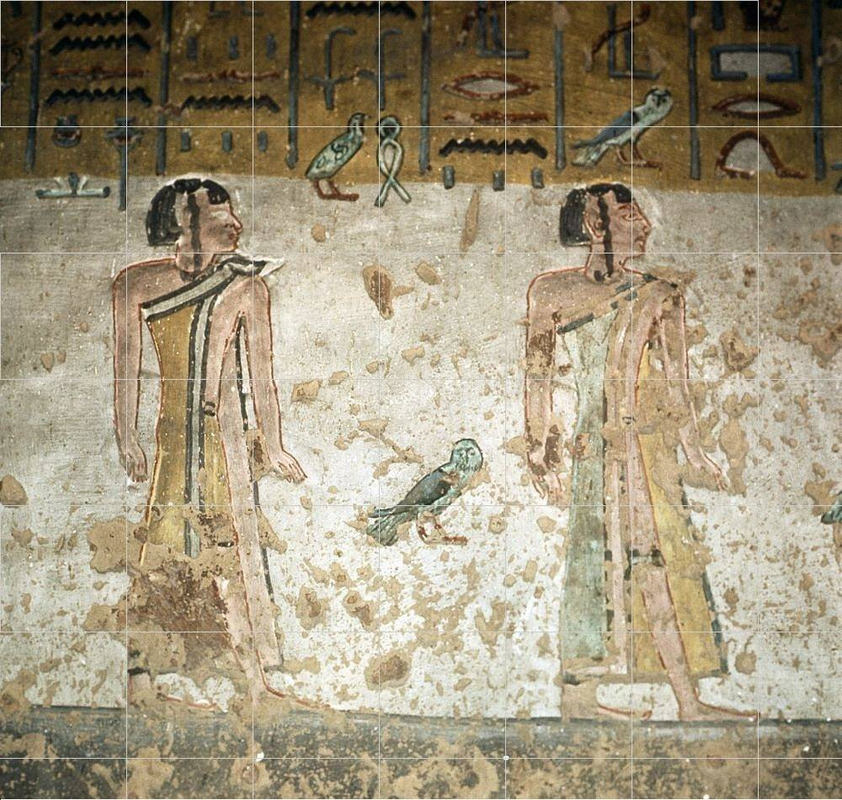

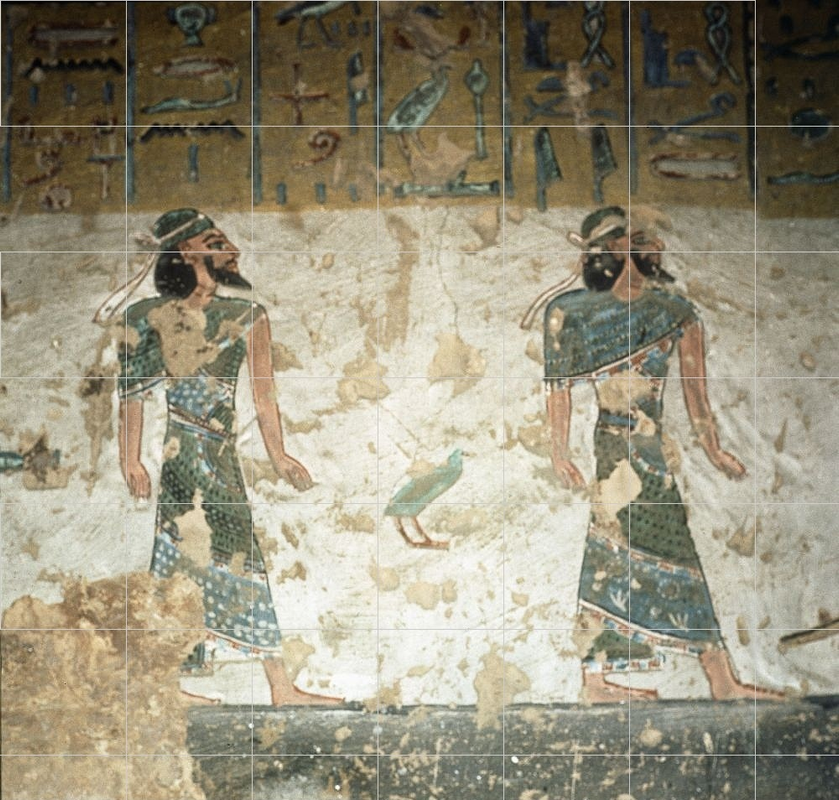





0 Response to "Art Quizletwhy Do Egyptian Frescos Survive in Such Remarkable Condition and Color?"
Post a Comment